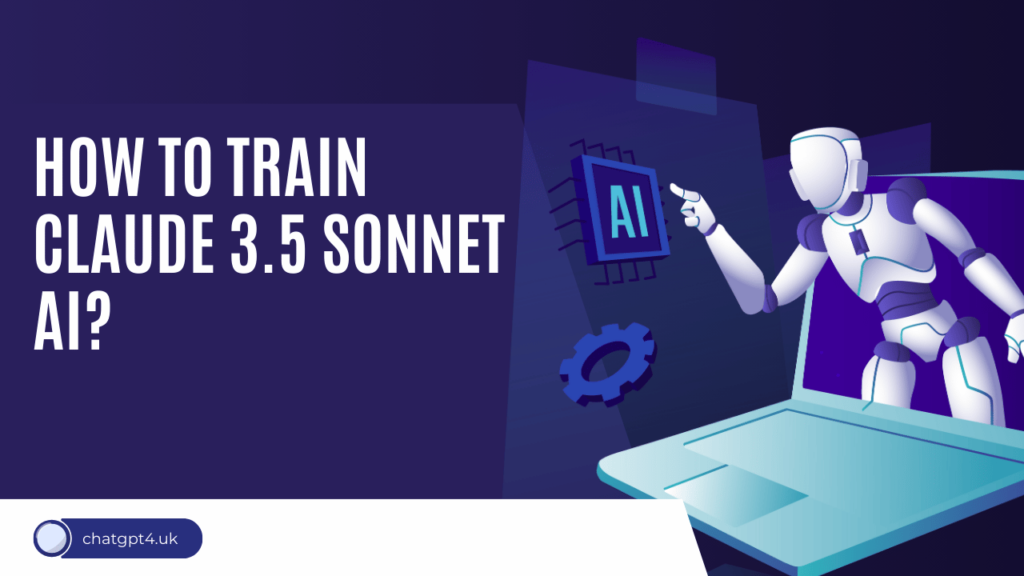Artificial Intelligence (AI) has seen rapid advancements, particularly in the area of natural language processing (NLP) and text generation. Models like Claude 3.5 Sonnet have revolutionized the way we interact with machines through text.
Claude 3.5 Sonnet is one of the advanced AI models, designed to understand and generate human-like text with exceptional coherence and creativity. But how can you train this sophisticated model to suit your specific needs?
This comprehensive guide will walk you through the entire process of training Claude 3.5 Sonnet, explaining each step from understanding the model architecture to deploying a finely-tuned system.
1. Understanding Claude 3.5 Sonnet
Claude 3.5 Sonnet is a large-scale language model, based on the Transformer architecture, similar to other AI models like GPT and BERT. It is designed to understand context and semantics, which allows it to generate meaningful and coherent text in response to prompts.
The model has been trained on vast datasets and is capable of generating creative works such as sonnets, essays, dialogues, and even technical documentation.
Key Features of Claude 3.5 Sonnet:
- Contextual Understanding: It can understand the context of large texts and respond accordingly.
- High Accuracy: The model achieves state-of-the-art performance in various NLP benchmarks.
- Creativity: It can generate text in multiple styles, including poetry, fiction, and academic content.
2. Key Components of Claude 3.5 Sonnet AI
Before diving into the training process, it is crucial to understand the fundamental components that make up Claude 3.5 Sonnet. These include:
- Transformer Architecture: A neural network structure that helps in understanding the relationships between words in a sentence. It uses attention mechanisms to process input more efficiently.
- Tokenization: The process of breaking down text into smaller components (tokens), which are fed into the model.
- Pre-trained Weights: These are the learned parameters from the initial training process on massive datasets.
- Fine-tuning Layer: The layer that you can train with your own data to adapt the model for specific tasks.
3. Why Train Claude 3.5 Sonnet?
Training Claude 3.5 Sonnet allows you to personalize the model for specific tasks and applications. Some of the reasons to train Claude 3.5 Sonnet include:
- Customizing Language Style: You can adapt the model to generate content in a particular tone or style.
- Domain-Specific Knowledge: Training on specific datasets allows the model to generate content that’s more relevant to industries like healthcare, finance, or law.
- Improved Accuracy: Fine-tuning Claude 3.5 Sonnet enhances its accuracy for niche tasks such as legal documentation or scientific papers.
- Creative Outputs: For creative projects like writing poetry or fiction, training the model helps in tailoring its outputs to fit a specific genre or theme.
4. Prerequisites for Training
Before starting the training process, you will need certain tools, knowledge, and resources:
- Hardware: A powerful GPU or TPU is necessary for training large AI models like Claude 3.5. You might also need cloud resources like Google Cloud or AWS for scalable training.
- Software Frameworks: You will need machine learning libraries like TensorFlow, PyTorch, or Hugging Face Transformers.
- Programming Language: Python is typically the go-to language for AI development.
- Dataset: A high-quality dataset related to the domain you are targeting is essential for effective training.
- Storage and Memory: Training large models can require hundreds of gigabytes or even terabytes of storage and memory.
5. Data Collection and Preparation
The success of training an AI model largely depends on the quality of the dataset. Here’s how to go about collecting and preparing your data for Claude 3.5 Sonnet:

Types of Data to Collect:
- Text Data: You need text that reflects the language style or domain you’re aiming for. This could include books, articles, blogs, or research papers.
- Labeled Data (Optional): For specific tasks like classification, labeled data is essential.
- Publicly Available Datasets: You can also leverage publicly available datasets, such as those from academic repositories, Kaggle, or government datasets.
Key Steps in Data Preparation:
- Data Annotation: Label your dataset appropriately if you are aiming for a task like sentiment analysis or classification.
- Data Cleaning: Remove any irrelevant data, duplicate entries, or corrupt files.
- Data Splitting: Split the dataset into training, validation, and test sets to ensure that the model is generalizing well.
- Tokenization: The text data needs to be tokenized into a format that Claude 3.5 Sonnet can process.
6. Cleaning and Preprocessing the Data
Data preprocessing is a crucial step in ensuring that the input fed to the AI is clean and useful. Here’s how to do it:
- Removing Special Characters: Special characters, emojis, and symbols that are not part of the text generation task should be removed.
- Lowercasing: Convert all text to lowercase to maintain consistency.
- Stop Words Removal: Words like “the,” “and,” and “is” may be removed, depending on the task.
- Lemmatization and Stemming: Reduce words to their base form, so that similar words are treated alike.
7. Configuring the Claude 3.5 Sonnet Model
Once your data is ready, the next step is to configure Claude 3.5 Sonnet for training. This involves selecting the right architecture, initializing the model, and setting the parameters.
Key Configuration Steps:
- Model Initialization: Load the pre-trained Claude 3.5 Sonnet model into your training environment.
- Setting Hyperparameters: Choose parameters like learning rate, batch size, and number of epochs. These will influence how fast the model learns and the quality of the final output.
- Optimizer: Use an optimization algorithm such as Adam or SGD (Stochastic Gradient Descent) to minimize the error during training.
- Loss Function: Choose the right loss function based on the task (e.g., cross-entropy loss for text classification).
8. Training Claude 3.5: A Step-by-Step Guide
Hardware Setup
Ensure that your system is optimized for handling the computational load. You can either use a local high-end GPU or opt for cloud-based resources such as Google Colab or AWS for more scalable solutions.
Choosing the Right Framework
You’ll need to choose the right machine learning framework to train Claude 3.5 Sonnet. Some of the popular options include:
- TensorFlow: Google’s powerful ML framework, ideal for large-scale models.
- PyTorch: A flexible and user-friendly framework with dynamic computation graphs.
- Hugging Face Transformers: A library designed for transformer-based models like Claude 3.5.
Optimizing Hyperparameters
Hyperparameter tuning is essential to achieving the best performance. Some key parameters to focus on are:
- Learning Rate: Determines how quickly the model updates its parameters.
- Batch Size: The number of samples processed at once during training.
- Epochs: The number of complete passes through the dataset.
Fine-Tuning the Model
Fine-tuning allows you to adapt the pre-trained model to specific tasks by training it on a smaller, domain-specific dataset. This process involves:
- Loading the Pre-Trained Model: Start with Claude 3.5’s pre-trained weights.
- Training on Specific Data: Use your own dataset to fine-tune the model to your needs.
- Freezing Layers: Depending on your task, you may choose to freeze some layers and only train certain parts of the model.
9. Evaluation and Testing of Claude 3.5 Sonnet AI
Once your model is trained, it’s crucial to evaluate its performance. Testing involves comparing the model’s output with real-world data or predefined benchmarks. Here’s how you can evaluate your model:
- Perplexity: This measures how well the model predicts a sample of text. A lower perplexity score indicates better performance.
- BLEU Score: This is a metric for evaluating the quality of text by comparing it to reference sentences.
- Human Evaluation: In some cases, you might need human reviewers to evaluate the quality of the AI-generated text.
10. Challenges and How to Overcome Them
Training an AI model like Claude 3.5 Sonnet comes with various challenges:
- Data Scarcity: You may not always have enough data to train your model effectively. To overcome this, consider using data augmentation techniques or pre-trained models.
- Overfitting: If the model performs well on the training data but poorly on the validation data, it’s overfitting. You can use techniques like dropout or early stopping to mitigate this.
- Hardware Limitations: Large models require a lot of computational power. Cloud-based solutions like AWS, Azure, or Google Cloud can provide scalable resources.
11. Deploying the Trained Model
Once trained, you can deploy your Claude 3.5 Sonnet model for practical use. Here are the steps involved in deployment:
- Model Export: Convert the trained model into a format that’s compatible with your deployment platform (e.g., TensorFlow Lite for mobile, ONNX for general purposes).
- API Integration: Use REST APIs or gRPC to serve your model and make it accessible via an application.
- Cloud Deployment: Deploy your model on cloud platforms like AWS, Google Cloud, or Azure for scalability and accessibility.
12. Monitoring and Maintenance Post-Training
Training a model is only the beginning. Continuous monitoring and maintenance are crucial for ensuring that the model performs well over time.
- Performance Monitoring: Keep track of key metrics such as response time, accuracy, and resource usage.
- Model Updates: Retrain the model periodically to improve its performance and keep it up-to-date with new data.
- Handling User Feedback: Integrate mechanisms for gathering user feedback and using it to improve the model.
13. Use Cases of a Trained Claude 3.5 Sonnet AI
After training Claude 3.5 Sonnet, it can be used in various domains:
- Content Generation: Generate blog posts, articles, or creative writing.
- Customer Service: Create AI-powered chatbots for handling customer queries.
- Academic Writing: Generate technical papers or assist with academic research.
- Entertainment: Produce scripts for movies, games, or interactive storytelling.
14. Future Trends in AI Training
The field of AI and NLP is continuously evolving. Some emerging trends include:
- Few-Shot Learning: Models that require fewer examples to perform tasks.
- Multimodal AI: Combining text, image, and audio data to create more versatile models.
- Transfer Learning: Using models trained on one task to perform well on another with minimal re-training.
- Ethical AI: Ensuring that AI models are trained and deployed in a way that avoids bias and promotes fairness.
15. Conclusion
Training Claude 3.5 Sonnet AI can be a complex but rewarding process. From data collection and preprocessing to fine-tuning and deployment, every step plays a crucial role in shaping how well the model performs in real-world scenarios.
With the right tools, knowledge, and resources, you can adapt Claude 3.5 Sonnet to generate high-quality, domain-specific content that meets your specific needs. Keep in mind that AI models require continuous monitoring and maintenance to ensure they remain effective over time.







